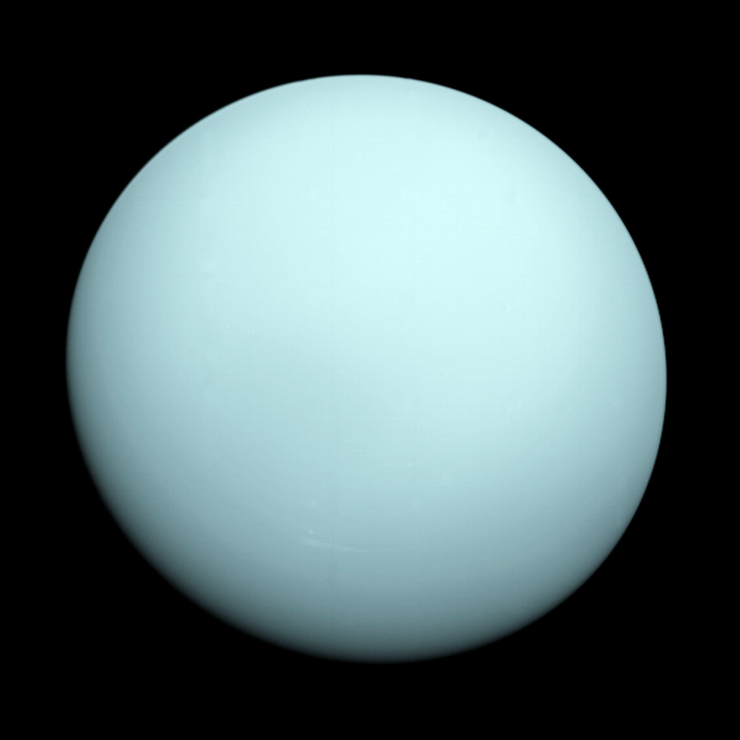Uranus May Have Odd, Strobe-Like Magnetic Field

The planet Uranus just keeps getting weirder.
The icy gas world that strangely orbits the sun on its side may also have a wonky magnetic field that constantly flickers on and off, new research suggests.
Magnetic fields around planets, or magnetospheres, create shields against the bombardment of radiation from the sun known as solar wind. On Earth, for example, the magnetosphere lines up pretty closely with the planet's axis of rotation, and magnetic field lines emerge from Earth's north and south poles. On Uranus, however, the magnetosphere is a bit more chaotic.
Uranus' spin axis is tilted by a whopping 98 degrees, and the planet's off-center magnetic field is tilted by another 60 degrees. Every time the planet rotates (about every 17.24 hours), this lopsided magnetic field tumbles around, opening and closing periodically as the magnetic field lines disconnect and reconnect, the study found. [Top 5 Weird Facts About Uranus]
Researchers at the Georgia Institute of Technology (Georgia Tech) in Atlanta figured this out by simulating Uranus' messy magnetosphere using numerical models and data from NASA's Voyager 2 spacecraft, which flew by the planet in 1986.
"Uranus is a geometric nightmare," Carol Paty, an associate professor at Georgia Tech's School of Earth & Atmospheric Sciences and co-author of the study, said in a statement. "The magnetic field tumbles very fast, like a child cartwheeling down a hill head over heels. When the magnetized solar wind meets this tumbling field in the right way, it can reconnect, and [so] Uranus' magnetosphere goes from open to closed to open on a daily basis."
When the magnetosphere opens up, it allows solar particles to bombard the planet. Then, when the magnetic field lines reconnect, this natural shield can continue to block the solar wind.
Get the Space.com Newsletter
Breaking space news, the latest updates on rocket launches, skywatching events and more!
This process may be related to auroras on Uranus. Just like the auroras on Earth and other planets, Uranus' atmosphere lights up when particles from the solar wind enter it and interact with gases like nitrogen and oxygen.
NASA's Hubble Space Telescope has previously observed auroras on Uranus, but astronomers face difficulties in studying how these auroras interact with the magnetosphere, because the planet is so far away — nearly 2 billion miles (3.2 billion kilometers) from Earth. The space agency is currently considering sending another spacecraft to Uranus and Neptune to investigate those planet's magnetic fields, among other things.
Xin Cao, a Ph.D. candidate at Georgia Tech who led the study, said that studying Uranus can teach scientists a lot about planets outside of the solar system. "The majority of exoplanets [worlds outside the solar system] that have been discovered appear to also be ice giants in size," he said. "Perhaps what we see on Uranus and Neptune is the norm for planets: very unique magnetospheres and less-aligned magnetic fields.
"Understanding how these complex magnetospheres shield exoplanets from stellar radiation is of key importance for studying the habitability of these newly discovered worlds," Cao added.
The results of this study were published June 27 in the Journal of Geophysical Research: Space Physics.
Email Hanneke Weitering at hweitering@space.com or follow her @hannekescience. Follow us @Spacedotcom, Facebook and Google+. Original article on Space.com.
Join our Space Forums to keep talking space on the latest missions, night sky and more! And if you have a news tip, correction or comment, let us know at: community@space.com.

Hanneke Weitering is a multimedia journalist in the Pacific Northwest reporting on the future of aviation at FutureFlight.aero and Aviation International News and was previously the Editor for Spaceflight and Astronomy news here at Space.com. As an editor with over 10 years of experience in science journalism she has previously written for Scholastic Classroom Magazines, MedPage Today and The Joint Institute for Computational Sciences at Oak Ridge National Laboratory. After studying physics at the University of Tennessee in her hometown of Knoxville, she earned her graduate degree in Science, Health and Environmental Reporting (SHERP) from New York University. Hanneke joined the Space.com team in 2016 as a staff writer and producer, covering topics including spaceflight and astronomy. She currently lives in Seattle, home of the Space Needle, with her cat and two snakes. In her spare time, Hanneke enjoys exploring the Rocky Mountains, basking in nature and looking for dark skies to gaze at the cosmos.









